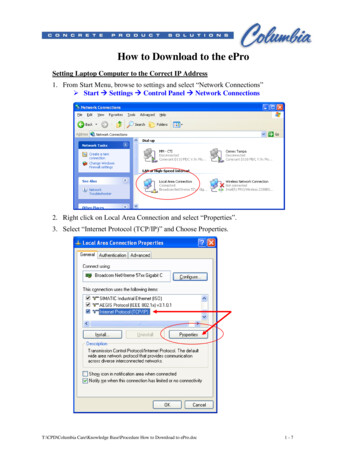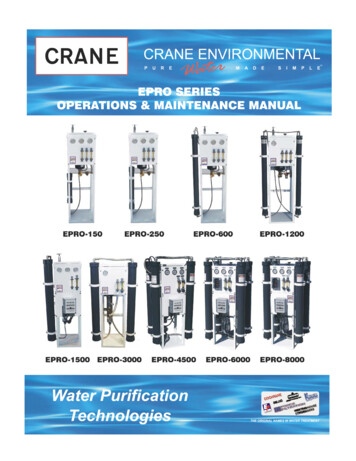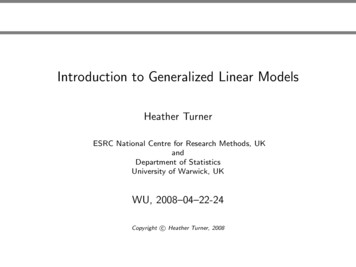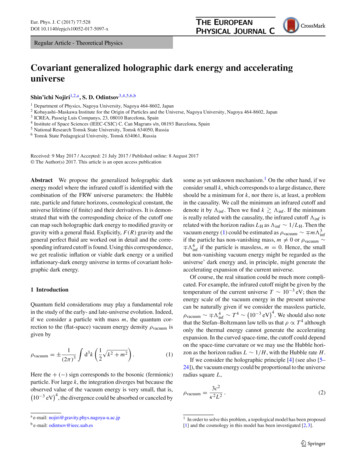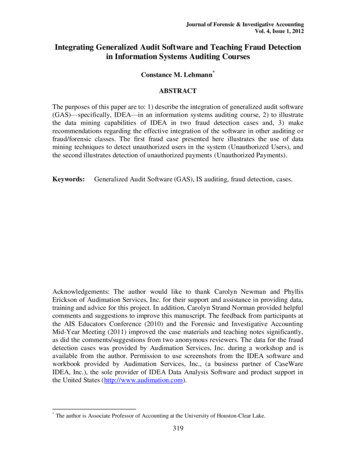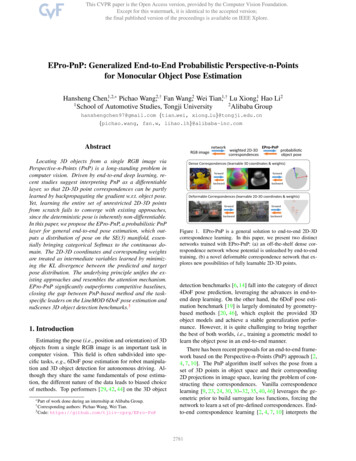
Transcription
EPro-PnP: Generalized End-to-End Probabilistic Perspective-n-Pointsfor Monocular Object Pose EstimationHansheng Chen,1,2,* Pichao Wang,2,† Fan Wang,2 Wei Tian,1,† Lu Xiong,1 Hao Li212School of Automotive Studies, Tongji UniversityAlibaba Grouphanshengchen97@gmail.com {tian wei, xiong lu}@tongji.edu.cn{pichao.wang, fan.w, lihao.lh}@alibaba-inc.comAbstractnetworkRGB imageLocating 3D objects from a single RGB image viaPerspective-n-Points (PnP) is a long-standing problem incomputer vision. Driven by end-to-end deep learning, recent studies suggest interpreting PnP as a differentiablelayer, so that 2D-3D point correspondences can be partlylearned by backpropagating the gradient w.r.t. object pose.Yet, learning the entire set of unrestricted 2D-3D pointsfrom scratch fails to converge with existing approaches,since the deterministic pose is inherently non-differentiable.In this paper, we propose the EPro-PnP, a probabilistic PnPlayer for general end-to-end pose estimation, which outputs a distribution of pose on the SE(3) manifold, essentially bringing categorical Softmax to the continuous domain. The 2D-3D coordinates and corresponding weightsare treated as intermediate variables learned by minimizing the KL divergence between the predicted and targetpose distribution. The underlying principle unifies the existing approaches and resembles the attention mechanism.EPro-PnP significantly outperforms competitive baselines,closing the gap between PnP-based method and the taskspecific leaders on the LineMOD 6DoF pose estimation andnuScenes 3D object detection benchmarks.31. IntroductionEstimating the pose (i.e., position and orientation) of 3Dobjects from a single RGB image is an important task incomputer vision. This field is often subdivided into specific tasks, e.g., 6DoF pose estimation for robot manipulation and 3D object detection for autonomous driving. Although they share the same fundamentals of pose estimation, the different nature of the data leads to biased choiceof methods. Top performers [29, 42, 44] on the 3D object* Part of work done during an internship at Alibaba† Corresponding authors: Pichao Wang, Wei Tian.3 eighted 2D-3DcorrespondencesEPro-PnPprobabilis!cobject poseDense Correspondences (learnable 3D coordinates & weights)forwardforwardbackwardbackwardDeformable Correspondences (learnable 2D-3D coordinates & weights)forwardforwardbackwardbackwardFigure 1. EPro-PnP is a general solution to end-to-end 2D-3Dcorrespondence learning. In this paper, we present two distinctnetworks trained with EPro-PnP: (a) an off-the-shelf dense correspondence network whose potential is unleashed by end-to-endtraining, (b) a novel deformable correspondence network that explores new possibilities of fully learnable 2D-3D points.detection benchmarks [6, 14] fall into the category of direct4DoF pose prediction, leveraging the advances in end-toend deep learning. On the other hand, the 6DoF pose estimation benchmark [19] is largely dominated by geometrybased methods [20, 46], which exploit the provided 3Dobject models and achieve a stable generalization performance. However, it is quite challenging to bring togetherthe best of both worlds, i.e., training a geometric model tolearn the object pose in an end-to-end manner.There has been recent proposals for an end-to-end framework based on the Perspective-n-Points (PnP) approach [2,4, 7, 10]. The PnP algorithm itself solves the pose from aset of 3D points in object space and their corresponding2D projections in image space, leaving the problem of constructing these correspondences. Vanilla correspondencelearning [9, 23, 24, 30, 30–32, 35, 40, 46] leverages the geometric prior to build surrogate loss functions, forcing thenetwork to learn a set of pre-defined correspondences. Endto-end correspondence learning [2, 4, 7, 10] interprets the2781
PnP as a differentiable layer and employs pose-driven lossfunction, so that gradient of the pose error can be backpropagated to the 2D-3D correspondences.However, existing work on differentiable PnP learnsonly a portion of the correspondences (either 2D coordinates [10], 3D coordinates [2, 4] or correspondingweights [7]), assuming other components are given a priori.This raises an important question: why not learn the entireset of points and weights altogether in an end-to-end manner? The simple answer is: the solution of the PnP problem is inherently non-differentiable at some points, causingtraining difficulties and convergence issues. More specifically, a PnP problem can have ambiguous solutions [27,33],which makes backpropagation unstable.To overcome the above limitations, we propose a generalized end-to-end probabilistic PnP (EPro-PnP) approachthat enables learning the weighted 2D-3D point correspondences entirely from scratch (Figure 1). The main ideais straightforward: deterministic pose is non-differentiable,but the probability density of pose is apparently differentiable, just like categorical classification scores. Therefore,we interpret the output of PnP as a probabilistic distributionparameterized by the learnable 2D-3D correspondences.During training, the Kullback-Leibler (KL) divergence between the predicted and target pose distributions is computed as the loss function, which is numerically tractableby efficient Monte Carlo pose sampling.As a general approach, EPro-PnP inherently unifies existing correspondence learning techniques (Section 3.1).Moreover, just like the attention mechanism [38], the corresponding weights can be trained to automatically focus onimportant point pairs, allowing the networks to be designedwith inspiration from attention-related work [8, 43, 48].To summarize, our main contributions are as follows: We propose the EPro-PnP, a probabilistic PnP layer forgeneral end-to-end pose estimation via learnable 2D3D correspondences. We demonstrate that EPro-PnP can easily reach toptier performance for 6DoF pose estimation by simplyinserting it into the CDPN [24] framework. We demonstrate the flexibility of EPro-PnP by proposing deformable correspondence learning for accurate3D object detection, where the entire 2D-3D correspondences are learned from scratch.2. Related WorkGeometry-Based Object Pose Estimation In general,geometry-based methods exploit the points, edges or othertypes of representation that are subject to the projectionconstraints under the perspective camera. Then, the posecan be solved by optimization. A large body of work utilizes point representation, which can be categorized intosparse keypoints and dense correspondences. BB8 [32] andRTM3D [23] locate the corners of the 3D bounding box askeypoints, while PVNet [31] defines the keypoints by farthest point sampling and Deep MANTA [9] by handcraftedtemplates. On the other hand, dense correspondence methods [11, 24, 30, 40, 46] predict pixel-wise 3D coordinateswithin a cropped 2D region. Most existing geometry-basedmethods follow a two-stage strategy, where the intermediaterepresentations (i.e., 2D-3D correspondences) are learnedwith a surrogate loss function, which is sub-optimal compared to end-to-end learning.End-to-End Correspondence Learning To mitigate thelimitation of surrogate correspondence learning, end-to-endapproaches have been proposed to backpropagate the gradient from pose to intermediate representation. By differentiating the PnP operation, Brachmann and Rother [4] propose a dense correspondence network where 3D points arelearnable, BPnP [10] predicts 2D keypoint locations, andBlindPnP [7] learns the corresponding weight matrix givena set of unordered 2D/3D points. Beyond point correspondence, RePOSE [20] proposes a feature-metric correspondence network trained in a similar end-to-end fashion. Theabove methods are all coupled with surrogate regularization loss, otherwise convergence is not guaranteed due tothe non-differentiable nature of deterministic pose. Underthe probabilistic framework, these methods can be regardedas a Laplace approximation approach (Section 3.1) or a local regularization technique (Section 3.4).Probabilistic Deep Learning Probabilistic methods account for uncertainty in the model and the data, known respectively as epistemic and aleatoric uncertainty [21]. Thelatter involves interpreting the prediction as learnable probabilistic distributions. Discrete categorical distribution viaSoftmax has been widely adopted as a smooth approximation of one-hot arg max for end-to-end classification. Thisinspired works such as DSAC [2], a smooth RANSAC witha finite hypothesis pool. Meanwhile, simple parametric distributions (e.g., normal distribution) are often used in predicting continuous variables [11,15,18,21,22,45], and mixture distributions can be employed to further capture ambiguity [1,3,26], e.g., ambiguous 6DoF pose [5]. In this paper,we propose yet a unique contribution: backpropagating acomplicated continuous distribution derived from a nestedoptimization layer (the PnP layer), essentially making thecontinuous counterpart of Softmax tractable.3. Generalized End-to-End Probabilistic PnP3.1. OverviewGivenproposal, our goal is to predict a set an object2D2DX x3D,x,wi 1 · · · N of N correspondingiiipoints, with 3D object coordinates x3D R3 , 2D imagei2D2coordinates xi R , and 2D weights wi2D R2 , from2782
fi(y) R2where π(·) is the projection function with camera intrinsicsinvolved, stands for element-wise product, and fi (y) compactly denotes the weighted reprojection error.Eq. (1) formulates a non-linear least squares problemthat may have non-unique solutions, i.e., pose ambiguity [27, 33]. Previous work [4, 7, 10] only backpropagatesthrough a local solution y , which is inherently unstable andnon-differentiable. To construct a differentiable alternativefor end-to-end learning, we model the PnP output as a distribution of pose, which guarantees differentiable probabilitydensity. Consider the cumulative error to be the negativelogarithm of the likelihood function p(X y) defined as:Np(X y) exp 1X2kfi (y)k .2 i 1(2)With an additional prior pose distribution p(y), we can derive the posterior pose p(y X) via the Bayes theorem. Using an uninformative prior, the posterior density is simplified to the normalized likelihood:PN2exp 12 i 1 kfi (y)kp(y X) R.(3)PN2exp 12 i 1 kfi (y)k dyEq. (3) can be interpreted as a continuous counterpart ofcategorical Softmax.KL Loss Function During training, given a target posedistribution with probability density t(y), the KL divergence DKL (t(y)kp(y X)) is minimized as training loss. Intuitively, pose ambiguity can be captured by the multiplemodes of p(y X), and convergence is ensured such thatwrong modes are suppressed by the loss function. Dropping the constant, the KL divergence loss can be written as:ZZLKL t(y) log p(X y) dy log p(X y) dy. (4)We empirically found it effective to set a narrow (Diraclike) target distribution centered at the ground truth ygt ,yielding the simplified loss (after substituting Eq. (2)):ZNN1X1X22LKL kfi (ygt )k log exp kfi (y)k dy .2 i 12 i 1{z} {z} Ltgt (reproj. at target pose)Lpred (reproj. at predicted pose)(5)The only remaining problem is the integration in the secondterm, which is elaborated in Section 3.2.Unnormalized Prob.which a weighted PnP problem can be formulated to estimate the object pose relative to the camera.The essence of a PnP layer is searching for an optimalpose y (expanded as rotation matrix R and translation vector t) that minimizes the cumulative squared weighted reprojection error:N 21 X 2D2D, (1)wi π(Rx3Darg mini t) xi2{z} yi 1g.t.Propoer LossDiscrete Classifica onImpropoer Lossg.t.g.t.Con nuous PoseCon nuous PoseFigure 2. Learning a discrete classifier vs. Learning the continuous pose distribution. A discriminative loss function (left) shallencourage the unnormalized probability for the correct predictionas well as penalize for the incorrect. A one-sided loss (right) willdegrade the distribution if the model is not well-regularized.Comparison to Reprojection-Based Method The twoterms in Eq. (5) are concerned with the reprojection errors attarget and predicted pose respectively. The former is oftenused as a surrogate loss in previous work [4, 10, 11]. However, the first term alone cannot handle learning all 2D-3Dpoints without imposing strict regularization, as the minimization could simply drive all the points to a concentratedlocation without pose discrimination. The second term originates from the normalization factor in Eq. (3), and is crucialto a discriminative loss function, as shown in Figure 2.Comparison to Implicit Differentiation Method Existing work on end-to-end PnP [7,10] derives a single solutionof a particular solver y PnP (X) via implicit functiontheorem [16]. In the probabilistic framework, this is essentially the Laplace method that approximates the posteriorby N (y , Σy ), where both y and Σy can be estimatedby the PnP solver with analytical derivatives [11]. A specialcase is that, with Σy simplified to be homogeneous, the approximated KL divergence can be simplified to the L2 lossky ygt k2 used in [7]. However, the Laplace approximation is inaccurate for non-normal posteriors with ambiguity,therefore does not guarantee global convergence.3.2. Monte Carlo Pose LossIn this section, we introduce a GPU-friendly efficientMonte Carlo approach to the integration in the proposedloss function, based on the Adaptive Multiple ImportanceSampling (AMIS) algorithm [12].Considering q(y) to be the probability density functionof a proposal distributionthe shape of thePN that approximates2integrand exp 21 i 1 kfi (y)k , and yj to be one of the Ksamples drawn from q(y), the estimation of the second termLpred in Eq. (5) is thus:PNK21 X exp 21 i 1 kfi (yj )kLpred log,(6)K j 1q(yj ) {z}vj (importance weight)where vj compactly denotes the importance weight at yj .Eq. (6) gives the vanilla importance sampling, where the2783
choice of proposal q(y) strongly affects the numerical stability. The AMIS algorithm is a better alternative as it iteratively adapts the proposal to the integrand.In brief, AMIS utilizes the sampled importance weightsfrom past iterations to estimate the new proposal. Then, allprevious samples are re-weighted as being homogeneouslysampled from a mixture of the overall sum of proposals.Initial proposal can be determined by the mode and covariance of the predicted pose distribution (see supplementaryfor details). A pseudo-code is given in Algorithm 1.Choice of Proposal Distribution The proposal distributions for position and orientation have to be chosen separately in a decoupled manner, since the orientation space isnon-Euclidean. For position, we adopt the 3DoF multivariate t-distribution. For 1D yaw-only orientation, we use amixture of von Mises and uniform distribution. For 3D orientation represented by unit quaternion, the angular centralGaussian distribution [37] is adopted.Algorithm 1: AMIS-based Monte Carlo pose loss1234562D2DInput : X {x3Di , xi , wi }Output: Lpredy , Σy PnP (X)// Laplace approximationFit q1 (y) to y , Σy // initial proposalfor 1 t T dotGenerate K 0 samples yj 1···K0 from qt (y)0for 1 j K doPN2// eval integrandPjt exp 12 i 1 fi (yjt )789for 1 τ t and 1 j K 0 doPtQτj 1t m 1 qm (yjτ )// eval proposal mixvjτ Pjτ /Qτj// importance weightif t T thenEstimate qt 1 (y) from all weighted samples{yjτ , vjτ 1 τ t, 1 j K 0 }PT PK 0 t112 Lpred log T K0t 1j 1 vj10113.3. BackpropagationIn general, the partial derivatives of the loss function defined in Eq. (5) is:NN 1X 1X LKL22kfi (ygt )k Ekfi (y)k , (·) (·) 2 i 1y p(y X) (·) 2i 1(7)where the first term is the gradient of reprojection errors attarget pose, and the second term is the expected gradient ofreprojection errors over predicted pose distribution, whichis approximated by backpropagating each weighted samplein the Monte Carlo pose loss.Balancing Uncertainty and Discrimination Considerthe negative gradient w.r.t. the corresponding weights wi2D : LKL2D 2 2 w r(y) r(y),(8)Egtiii wi2Dy p(y X)2Dwhere ri (y) π(Rx3Di t) xi (unweighted reprojec 2tion error), and (·) stands for element-wise square. Thefirst bracketed term ri 2 (ygt ) with negative sign indicatesthat correspondences with large reprojection error (hencehigh uncertainty) shall be weighted less. The second termEy p(y X) ri 2 (y) is relevant to the variance of reprojectionerror over the predicted pose. The positive sign indicatesthat sensitive correspondences should be weighted more,because they provide stronger pose discrimination. The final gradient is thus a balance between the uncertainty anddiscrimination, as shown in Figure 3. Existing work [11,31]on learning uncertainty-aware correspondences only considers the former, hence lacking the discriminative ability.3.4. Local Regularization of DerivativesWhile the KL divergence is a good metric for the probabilistic distribution, for inference it is still required to es-underlying tydiscrimina!on(pose sensi!vity)Figure 3. The learned corresponding weight can be factorizedinto inverse uncertainty and discrimination. Typically, inverse uncertainty roughly resembles the foreground mask, while discrimination emphasizes the 3D extremities of the object.timate the exact pose y by solving the PnP problem inEq. (1). The common choice of high precision is to utilizethe iterative PnP solver based on the Levenberg-Marquardt(LM) algorithm – a robust variant of the Gauss-Newton(GN) algorithm, which solves the non-linear least squaresby the first and approximated second order derivatives. Toaid derivative-based optimization, we regularize the derivatives of the log density log p(y X) w.r.t. the pose y, by encouraging the LM step y to find the true pose ygt .To employ the regularization during training, a detachedsolution y is obtained first. Then, at y , another iterationstep is evaluated via the GN algorithm (which ideally equals0 if y has converged to the local optimum): y (J T J εI) 1 J T F (y ),(9) TT(y ) is the conwhere F (y ) f1T (y ), f2T (y ), · · · , fNcatenated weighted reprojection errors of all points, J F (y)/ y T y y is the Jacobian matrix, and ε is a smallvalue for numerical stability. Note that y is analyticallydifferentiable. We therefore design the regularization lossas follows:Lreg l(y y, ygt ),(10)2784
linear, expwhere l(·, ·) is a distance metric for pose. We adopt smoothL1 for position and cosine similarity for orientation (seesupplementary materials for details). Note that the gradientis only backpropagated through y, encouraging the stepto be non-zero if y 6 ygt .It is worth noting that this regularization loss is very similar to the loss function derived from implicit differentiation [7, 10], and it can be used for training pose refinementnetworks within a limited scope [20].4. Attention-Inspired Correspondence NetworksAs discussed in Section 3.3, the balance between uncertainty and discrimination enables locating important correspondences in an attention-like manner. This inspires us totake elements from attention-related work, i.e., the Softmaxlayer and the deformable sampling [48].In this section, we present two networks with EPro-PnPlayer for 6DoF pose estimation and 3D object detection, respectively. For the former, EPro-PnP is incorporated intothe existing dense correspondence architecture [24]. For thelatter, we propose a radical deformable correspondence network to explore the flexibility of EPro-PnP.4.1. Dense Correspondence NetworkFor a strict comparison against existing PnP-based poseestimators, this paper takes the network from CDPN [24] asa baseline, adding minor modifications to fit the EPro-PnP.The original CDPN feeds cropped image regions withinthe detected 2D boxes into the pose estimation network, towhich two decoupled heads are appended for rotation andtranslation respectively. The rotation head is PnP-basedwhile the translation head uses direct regression. This paperdiscards the translation head to focus entirely on PnP.Modifications are only made to the output layers. Asshown in Figure 4, the original confidence map is expandedto two-channel XY weights with spatial Softmax and dynamic global weight scaling. Inspired by the attentionmechanism [38], the Softmax layer is a vital element forstable training, as it translates the absolute correspondingweights into a relative measurement. On the other hand, theglobal weight scaling factors represent the global concentration of the predicted pose distribution, ensuring a betterconvergence of the KL divergence loss.The dense correspondence network can be trained solelywith the KL divergence loss LKL to achieve decent performance. For top-tier performance, it is still beneficial to utilize additional coordinate regression as intermediate supervision, not to stabilize convergence but to introduce the geometric knowledge from the 3D models. Therefore, we keepthe masked coordinate regression loss from CDPN [24] butleave out its confidence loss. Furthermore, the performancepixel crd map2x64x64256x1x1global scale2x1x1spatialsoftmax2x64x64CNNcroppedimage (CDPN backbone rot head)weight map2x64x643D crd map3x64x64Figure 4. The 6DoF pose estimation network modified fromCDPN [24]. with spatial Softmax and global weight scaling.can be elevated by imposing the regularization loss Lreg inEq. (10).4.2. Deformable Correspondence NetworkInspired by Deformable DETR [48], we propose a noveldeformable correspondence network for 3D object detection, in which the entire 2D-3D coordinates and weights arelearned from scratch.As shown in Figure 5, the deformable correspondencenetwork is an extension of the FCOS3D [41] framework.The original FCOS3D is a one-stage detector that directlyregresses the center offset, depth, and yaw orientation ofmultiple objects for 4DoF pose estimation. In our adaptation, the outputs of the multi-level FCOS head [36] aremodified to generate object queries instead of directly predicting the pose. Also inspired by Deformable DETR [48],the appearance and position of a query is disentangled intothe embedding vector and the reference point. A multi-headdeformable attention layer [48] is adopted to sample thekey-value pairs from the dense features, with the value projected into point-wise features, and meanwhile aggregatedinto the object-level features.The point features are passed into a subnet that predictsthe 3D points and corresponding weights (normalized bySoftmax). Following MonoRUn [11], the 3D points are setin the normalized object coordinate (NOC) space to handlecategorical objects of various sizes.The object features are responsible for predicting theobject-level properties: (a) the 3D score (i.e., 3D localization confidence), (b) the weight scaling factor (same as inSection 4.1), (c) the 3D box size for recovering the absolutescale of the 3D points, and (d) other optional properties (velocity, attribute) required by the nuScenes benchmark [6].The deformable 2D-3D correspondences can be learnedsolely with the KL divergence loss LKL , preferably in conjunction with the regularization loss Lreg . Other auxiliarylosses can be imposed onto the dense features for enhancedaccuracy. Details are given in supplementary materials.2785
FPNP3 P7objectembeddingconvP7 s128reference point(object center)centernessclassificationP6 s64obj queryP5 s32P4 s16P2 s4point featP2 P5P3 s8conv,upsample,concatsamplingdense feat s4self attn3D points (NOC)weights(training mode)EPro‐PnP2D pointsobj feat(inferring mode)3D score, weight scale, 3D size, (velocity, attribute)Figure 5. The deformable correspondence network based on the FCOS3D [41] detector. Note that the sampled point-wise features areshared by the point-level subnet and the deformable attention layer that aggregates the features for object-level predictions.5. Experiments5.1. Datasets and MetricsLineMOD Dataset and Metrics The LineMODdataset [19] consists of 13 sequences, each containingabout 1.2K images annotated with 6DoF poses of a singleobject. Following [3], the images are split into the trainingand testing sets, with about 200 images per object for training. For data augmentation, we use the same synthetic dataas in CDPN [24]. We use two common metrics for evaluation: ADD(-S) and n , n cm. The ADD measures whetherthe average deviation of the transformed model points isless than a certain fraction of the object’s diameter (e.g.,ADD-0.1d). For symmetric objects, ADD-S computesthe average distance to the closest model point. n , n cmmeasures the accuracy of pose based on angular/positionalerror thresholds. All metrics are presented as percentages.nuScenes Dataset and Metrics The nuScenes 3D objectdetection benchmark [6] provides a large scale of data collected in 1000 scenes. Each scene contains 40 keyframes,annotated with a total of 1.4M 3D bounding boxes from10 categories. Each keyframe includes 6 RGB images collected from surrounding cameras. The data is split into700/150/150 scenes for training/validation/testing. The official benchmark evaluates the average precision with truepositives judged by 2D center error on the ground plane.The mAP metric is computed by averaging over the thresholds of 0.5, 1, 2, 4 meters. Besides, there are 5 true positivemetrics: Average Translation Error (ATE), Average ScaleError (ASE), Average Orientation Error (AOE), AverageVelocity Error (AVE) and Average Attribute Error (AAE).Finally, there is a nuScenes detection score (NDS) computed as a weighted average of the above metrics.The Huber kernel with threshold δ is defined as:(s,s δ2 ,ρ(s) δ(2 s δ), s δ 2 .We use an adaptive threshold as described in the supplementary materials. For Monte Carlo pose loss, we set the AMISiteration count T to 4 and the number of samples per iteration K 0 to 128. The loss weights are tuned such that LKLproduces roughly the same magnitude of gradient as typical coordinate regression, while the gradient from Lreg arekept very low. The weight normalization technique in [11]is adopted to compute the dynamic loss weight for LKL .Training the Dense Correspondence Network Generalsettings are kept the same as in CDPN [24] (with ResNet34 [17] as backbone) for strict comparison, except that weincrease the batch size to 32 for less training wall time.The network is trained for 160 epochs by RMSprop on theLineMOD dataset [19]. To reduce the Monte Carlo overhead, 512 points are randomly sampled from the 64 64dense points to compute LKL .Training the Deformable Correspondence NetworkWe adopt the same detector architecture as in FCOS3D [41],with ResNet-101-DCN [13] as backbone. The network istrained for 12 epochs by the AdamW [25] optimizer, witha batch size of 12 images across 4 GPUs on the nuScenesdataset [6].5.3. Results on the LineMOD BenchmarkComparison to the CDPN baseline with Ablations Thecontributions of every single modification to CDPN [24] arerevealed in Table 1. From the results it can be observed that: The original CDPN heavily relies on direct positionregression, and the performance drops greatly (-17.46)when reduced to a pure PnP estimator, although theLM solver partially recovers the mean metric ( 6.29). Employing EPro-PnP with the KL divergence loss significantly improves the metric ( 13.84), outperforming CDPN-Full by a clear margin (65.88 vs. 63.21). The regularization loss proposed in Eq. (10) further elevates the performance ( 1.88).5.2. Implementation DetailsEPro-PnP Configuration For the PnP formulation inEq. (1), in practice the actual reprojection costs are robustified by the Huber kernel ρ(·):arg minyN 1X 2ρ kfi (y)k .2 i 1(12)(11)2786
Strong improvement ( 5.46) is seen when initializedfrom A1, because CDPN has been trained with the extra ground truth of object masks, providing a good initial state highlighting the foreground. Finally, the performance benefits ( 0.97) from moretraining epochs (160 ep. from A1 320 ep.) as equivalent to CDPN-Full [24] (3 stages 160 ep.).ADD(-S)ID MethodThe results clearly demonstrate that EPro-PnP can unleashthe enormous potential of the classical PnP approach, without any fancy network design or decoupling tricks.Comparison to the State of the Art As shown in Table 2,despite modified from the lower baseline, EPro-PnP easily reaches comparable performance to the top pose refinerRePOSE [20], which adds extra overhead to the PnP-basedinitial estimator PVNet [31]. Among all these entries, EProPnP is the most straightforward as it simply solves the PnPproblem itself, without refinement network [20, 46], disentangled translation [24,39], or multiple representations [35].Comparison to Implicit Differentiation and Reprojection Learning As shown in Table 3, when the coordinateregression loss is removed, both implicit differentiation andreprojection loss fail to learn the pose properly. Yet EProPnP manages to learn the coordinates from scratch, evenoutperforming CDPN without translation head (79.46 vs.74.54). This validates that EPro-PnP can be used as a general pose estimator without relying on geometric prior.Uncertainty and Discrimination In Table 3, Reprojection vs. Monte Carlo loss can be interpreted as uncertainty alone vs. uncertainty-discrimination balanced. Theresults reveal that uncertainty alone exhibits strong performance when intermediate coordinate supervision is available, while discrimination is the key element for learningcorrespondences from scratch.Contribution of End-to-End Weight/Coordinate Learning As shown in Table 1, detaching the weights from theend-to-end loss has a stronger impact to the performancethan detaching the coordinates ( 8.69 vs. 3.08), stressingthe importance of attention-like end-to-end weight learning.On the Importance of the Softmax Layer Learning thecorresponding weights without the normalization denominator of spatial Softmax (so it
Figure 1. EPro-PnP is a general solution to end-to-end 2D-3D correspondence learning. In this paper, we present two distinct networks trained with EPro-PnP: (a) an off-the-shelf dense cor-respondence network whose potential is unleashed by end-to-end training, (b) a novel deformable correspondence network that ex-


